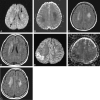Acute methotrexate neurotoxicity: findings on diffusion-weighted imaging and correlation with clinical outcome
- PMID: 15569732
- PMCID: PMC8148738
Acute methotrexate neurotoxicity: findings on diffusion-weighted imaging and correlation with clinical outcome
Abstract
Background and purpose: Acute lymphocytic leukemia (ALL) is a common malignancy of childhood treated with methotrexate (MTX), which is associated with acute neurotoxicity. We evaluated diffusion-weighted (DW) and conventional MR images in children with ALL and acute MTX-induced neurotoxicity, with clinical correlation.
Methods: Five patients aged 12-15 years underwent fluid-attenuated inversion recovery (FLAIR), T2-weighted fast spin-echo and gradient-echo, T1-weighted gadolinium-enhanced spin-echo, and DW imaging within 24 hours of symptom onset. Records were reviewed for the temporal relationship to MTX administration, strokelike symptoms, and neurologic outcome.
Results: Six strokelike events were temporally related to intrathecal MTX given 6-11 days before symptom onset. FLAIR images showed abnormal hyperintensity in the callosal splenium in one patient but were otherwise normal. Diffusion abnormalities were frontoparietal in three events and frontal in one; nonfluent aphasia was seen in all. Bilateral frontoparietal diffusion abnormalities were associated with bilateral upper-extremity weakness, right-sided hemiparesis, or left-sided hemiparesis (one patient each); one patient had mild facial droop. Unilateral precentral subcortical diffusion abnormality was associated with contralateral motor deficit and ipsilateral upper-extremity sensory loss. Strokelike symptoms resolved rapidly and were not associated with other signs of encephalopathy. Subsequent intrathecal MTX administration was not associated with recurrence in four patients.
Conclusion: Diffusion abnormalities in acute MTX neurotoxicity indicated cerebral dysfunction but not necessarily overt structural injury to the cerebrum. Subsequent demyelination or gliosis could not be predicted on the basis of diffusion abnormalities. A single strokelike episode with diffusion abnormalities should not necessarily prompt modification of potentially curative chemotherapeutic regimens.
Figures





Similar articles
-
Clinical and radiological characteristics of methotrexate-induced acute encephalopathy in pediatric patients with cancer.Ann Oncol. 2008 Jan;19(1):178-84. doi: 10.1093/annonc/mdm466. Epub 2007 Oct 17. Ann Oncol. 2008. PMID: 17947226
-
Neurotoxicity of intrathecal methotrexate: MR imaging findings.AJNR Am J Neuroradiol. 2003 Oct;24(9):1887-90. AJNR Am J Neuroradiol. 2003. PMID: 14561622 Free PMC article.
-
Transient encephalopathy after intrathekal methotrexate chemotherapy: diffusion-weighted MRI.J Neurooncol. 2005 May;73(1):47-9. doi: 10.1007/s11060-004-2929-y. J Neurooncol. 2005. PMID: 15933817
-
Methotrexate-related neurotoxicity in the treatment of childhood acute lymphoblastic leukemia.Isr Med Assoc J. 2002 Nov;4(11):1050-3. Isr Med Assoc J. 2002. PMID: 12489505 Review.
-
[Transient subacute encephalopathy induced by high-dose methotrexate treatment in children with acute lymphoblastic leukemia and malignant lymphoma].Gan To Kagaku Ryoho. 1992 Sep;19(11):1851-7. Gan To Kagaku Ryoho. 1992. PMID: 1519928 Review. Japanese.
Cited by
-
The effect of corticosteroid medication on quantitative MR parameters of the brain.AJNR Am J Neuroradiol. 2005 Nov-Dec;26(10):2475-80. AJNR Am J Neuroradiol. 2005. PMID: 16286387 Free PMC article. Clinical Trial.
-
Cancer-associated stroke: Pathophysiology, detection and management (Review).Int J Oncol. 2019 Mar;54(3):779-796. doi: 10.3892/ijo.2019.4669. Epub 2019 Jan 2. Int J Oncol. 2019. PMID: 30628661 Free PMC article. Review.
-
Neurotoxicity of Tumor Immunotherapy: The Emergence of Clinical Attention.J Oncol. 2022 Jan 18;2022:4259205. doi: 10.1155/2022/4259205. eCollection 2022. J Oncol. 2022. PMID: 35087588 Free PMC article. Review.
-
Methotrexate-induced Subacute Encephalopathy That Showed No Abnormalities on Magnetic Resonance Imaging Soon after Symptom Appearance.Intern Med. 2023 Aug 1;62(15):2249-2252. doi: 10.2169/internalmedicine.0855-22. Epub 2022 Dec 7. Intern Med. 2023. PMID: 36476551 Free PMC article.
-
Severe, Fatal Methotrexate-related Neurotoxicity in 2 Adolescent Patients With ALL.J Pediatr Hematol Oncol. 2020 Nov;42(8):e839-e844. doi: 10.1097/MPH.0000000000001706. J Pediatr Hematol Oncol. 2020. PMID: 31876782 Free PMC article.
References
-
- Winick NJ, Bowman WP, Kamen BA, et al. Unexpected acute neurologic toxicity in the treatment of children with acute lymphoblastic leukemia. J Natl Cancer Inst 1992;84:252–256 - PubMed
-
- Mahoney DH, Shuster JJ, Nitschke R, et al. Acute neurotoxicity in children with B-precursor acute lymphoid leukemia: an association between intermediate–dose intravenous methotrexate and intrathecal triple therapy: a Pediatric Oncology Group study. J Clin Oncol 1998;16:1712–1722 - PubMed
-
- Winick N, Shuster JJ, Bowman WP, et al. Intensive oral methotrexate protects against lymphoid marrow relapse in childhood B-precursor acute lymphoblastic leukemia. J Clin Oncol 1996;14:2803–2811 - PubMed
-
- Rubnitz JE, Relling MV, Harrison, et al. Transient leukoencephalopathy following high dose methotrexate treatment in childhood acute lymphocytic leukemia. Leukemia 1998;12:1176–1181 - PubMed
-
- Rubinstein LJ, Herman MM, Long TF, Wilbur JR. Disseminated necrotizing leukoencephalopathy: a complication of treated central nervous system leukemia and lymphoma. Cancer 1975;35:291–305 - PubMed
MeSH terms
Substances
LinkOut - more resources
Full Text Sources
